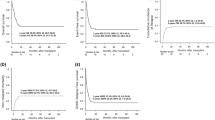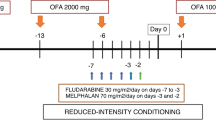Abstract
The standard approach for relapsed diffuse large B-cell lymphoma (DLBCL) involves auto-SCT. However, studies that established this approach were conducted before the inclusion of rituximab (R) with first-line therapy became routine. Whether DLBCL patients (pts) relapsing after first-line chemoimmunotherapy including R derive a comparable benefit from auto-SCT to pts in the pre-R era is unknown. We analyzed outcomes after auto-SCT for relapsed DLBCL among pts receiving initial R and those who did not. We reviewed 257 consecutive pts with relapsed DLBCL treated at our institution with auto-SCT. In all, 226 pts were included in the analysis, of whom 161 had received no R and 65 received R as part of first-line therapy (Planned R). Median OS and relapse-free survival, measured from transplant, were similar between No R vs Planned R groups: 67 vs 44 months (P=0.3) and 25 vs 27 months (P=0.8), respectively. A further analysis was carried out between two cohorts matched by propensity analysis. Again, no differences in outcomes were observed. This suggests that auto-SCT may be equally effective in pts relapsing after first-line therapy including R, and should remain the standard of care for relapsed DLBCL.
This is a preview of subscription content, access via your institution
Access options
Subscribe to this journal
Receive 12 print issues and online access
$259.00 per year
only $21.58 per issue
Buy this article
- Purchase on Springer Link
- Instant access to full article PDF
Prices may be subject to local taxes which are calculated during checkout




Similar content being viewed by others
References
Armitage JO, Weisenberger DD . New approach to classifying non-Hodgkin's lymphomas: clinical features of the major histologic subtypes. Non-Hodgkin's Lymphomas Classification Project. J Clin Oncol 1998; 16: 2780–2795.
Coiffier B, Lepage E, Brière J, Herbrecht R, Tilly H, Bouabdallah R et al. CHOP chemotherapy plus rituximab compared with CHOP alone in elderly patients with diffuse large-B-cell lymphoma. N Engl J Med 2002; 346: 235–242.
Feugier P, Van Hoof A, Sebban C, Solal-Celigny P, Bouabdallah R, Fermé C et al. Long-term results of the R-CHOP study in the treatment of elderly patients with diffuse large B-cell lymphoma: a study by the Groupe d'Etude des Lymphomes de l'Adulte. J Clin Oncol 2005; 23: 4117–4126.
Pfreundschuh M, Trümper L, Österborg A, Pettengell R, Trneny M, Imrie K et al. CHOP-like chemotherapy plus rituximab versus CHOP-like chemotherapy alone in young patients with good-prognosis diffuse large-B-cell lymphoma: a randomised controlled trial by the MabThera International Trial (MInT) Group. Lancet Oncol 2006; 7: 379–391.
Sehn L, Donaldson J, Chhanabhai M, Fitzgerald C, Gill K, Klasa R et al. Introduction of combined CHOP plus rituximab therapy dramatically improved outcome of diffuse large B-cell lymphoma in British Columbia. J Clin Oncol 2005; 23: 5027–5033.
Philip T, Guglielmi C, Hagenbeek A, Somers R, Van Der Lelie H, Bron D et al. Autologous bone marrow transplantation as compared with salvage chemotherapy in relapses of chemotherapy-sensitive non-Hodgkin's lymphoma. N Engl J Med 1995; 333: 1540–1545.
Guglielmi C, Gomez F, Philip T, Hagenbeek A, Martelli M, Sebban C et al. Time to relapse has prognostic value in patients with aggressive lymphoma enrolled onto the Parma trial. J Clin Oncol 1998; 16: 3264–3269.
Jaffe E, Harris N, Diebold J, Müller-Hermelink H . World Health Organization Classification of lymphomas: a work in progress. Ann Oncol 1998; 9 (Suppl 5): S25–S30.
Rosenbaum P, Rubin D . The central role of the propensity score in observational studies for causal effects. Biometrika 1983; 70: 41–55.
Parsons L . Reducing bias in a propensity score-matched-pair sample using greedy matching techniques. SAS Users Group International Conference 2001. SAS Institute, Inc.: Cary, NC.
Gisselbrecht C, Glass B, Mounier N, Gill D, Linch D, Trneny M . R-ICE versus R-DHAP in relapsed patients with CD20 diffuse large B-cell lymphoma (DLBCL) followed by autologous stem cell transplantation: CORAL study. J Clin Oncol 2009; 27: 15s(suppl; abstract 8509).
Veelken H, Dannheim S, Moenting J, Martens U, Finke J, Schmitt-Graeff A . Immunophenotype as prognostic factor for diffuse large B-cell lymphoma in patients undergoing clinical risk-adapted therapy. Ann Oncol 2007; 18: 931–939.
Vitolo U, Botto B, Capello D, Vivenza D, Zagonel V, Gloghini A et al. Point mutations of the BCL-6 gene: clinical and prognostic correlation in B-diffuse large cell lymphoma. Leukemia 2002; 16: 268–275.
Hallack Neto AE, Dulley FL, Coelho Siqueira SA, Pracchia LF, Belesso M, Saboya R et al. Prognostic impact of diffuse large B-cell lymphoma subgroups in patients undergoing autologous SCT. Bone Marrow Transplant 2008; 43: 323–325.
Costa LJ, Feldman AL, Micallef IN, Inwards DJ, Johnston PB, Porrata LF et al. Germinal center B (GCB) and non-GCB cell-like diffuse large B cell lymphomas have similar outcomes following autologous haematopoietic stem cell transplantation. Br J Haematol 2008; 142: 404–412.
Moskowitz CH, Zelenetz AD, Kewalramani T, Hamlin P, Lessac-Chenen S, Houldsworth J et al. Cell of origin, germinal center versus nongerminal center, determined by immunohistochemistry on tissue microarray, does not correlate with outcome in patients with relapsed and refractory DLBCL. Blood 2005; 106: 3383–3385.
Nyman H, Adde M, Karjalainen-Lindsberg ML, Taskinen M, Berglund M, Amini RM et al. Prognostic impact of immunohistochemically defined germinal center phenotype in diffuse large B-cell lymphoma patients treated with immunochemotherapy. Blood 2007; 109: 4930–4935.
Author information
Authors and Affiliations
Corresponding author
Ethics declarations
Competing interests
The authors declare no conflict of interest.
Rights and permissions
About this article
Cite this article
Smith, S., Bolwell, B., Rybicki, L. et al. Comparison of outcomes after auto-SCT for patients with relapsed diffuse large B-cell lymphoma according to previous therapy with rituximab. Bone Marrow Transplant 46, 262–266 (2011). https://doi.org/10.1038/bmt.2010.95
Received:
Revised:
Accepted:
Published:
Issue Date:
DOI: https://doi.org/10.1038/bmt.2010.95
Keywords
This article is cited by
-
BeEAM conditioning with bendamustine-replacing BCNU before autologous transplantation is safe and effective in lymphoma patients
Annals of Hematology (2017)
-
The Role of Transplantation in Diffuse Large B-Cell Lymphoma: The Impact of Rituximab Plus Chemotherapy in First-line and Relapsed Settings
Current Hematologic Malignancy Reports (2011)



